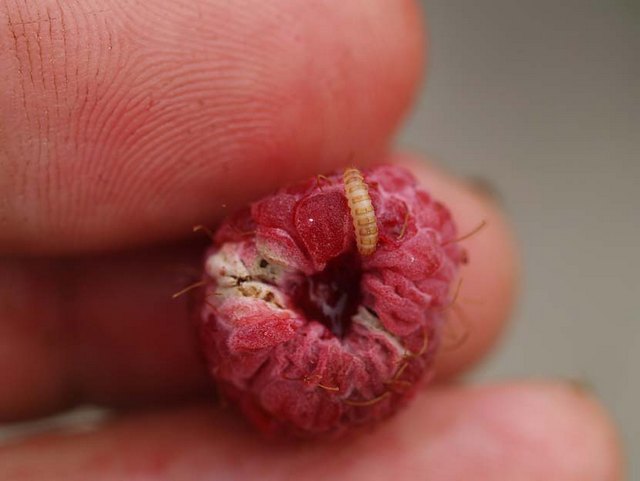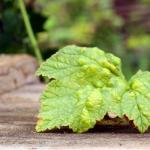
Raspberry beetle and methods of dealing with it
As a child, raspberries gave me an ambiguous impression: on the one hand, a good and tasty berry, and on the other, thorny bushes and worms in berries. Later, we collected forest raspberries (it is much tastier) only for jam, and all because this same worm came across in every second or third berry. Yes, and home (garden) berry, from time to time, contained a wriggling worm. Agree that it is unpleasant to look at and eat such a berry? If you are ripe for changes in your mind, then you can safely begin to get acquainted with our useful material.
The hero of the occasion - raspberry beetle
Naturally, worms, by themselves, do not appear (like flies from garbage). They have a parent who has a different hypostasis - a raspberry beetle. The raspberry beetle (lat. Byturus tomentosus) does not go far from the bushes for wintering; you can find the beetle itself and its larvae nearby in the upper soil layer (at a depth of 5-20 centimeters). Like many other pests, he cannot live without weeds. In the spring, raspberry beetles feed on nectar and pollen of weed flowers, gain strength, and only then move on to flowers of raspberries, currants, gooseberries and some fruit trees. As you all already understood, the beetle lays its larvae in young berries, and as the berries ripen, the larvae themselves grow. It is they who spoil the harvest of this berry.
Primarily, the beetle is taken for low-growing berries - garden strawberries. On raspberry bushes, beetles begin to move from June, before it blooms. If you scared the beetle by treating garden strawberries with something, then it will fly to raspberries even earlier than these dates. The pest does not disdain raspberry buds and flowers. Please note that only this pest can damage 15% of the total raspberry crop. Therefore, the fight against the raspberry beetle will bring tangible results.

Raspberry beetle female and larvae
The female raspberry beetle lays its clutch of eggs right in the raspberry flower. One female raspberry can produce 40 eggs. Each female strives to plant one larva on each ovary of berries so that there is no competition between them, and they develop well. Those. one female is capable of ruining dozens of berries. After 10 days, raspberry beetle larvae begin to appear, which gnaw wormholes in the berry. Larvae are in wormy berries for about 40-50 days. The berries are disfigured, smaller or rot. Before September, the larvae leave the fruit in the soil, where they successfully pupate. In this state, they will be until the spring of next year or under adverse weather conditions for two years in a row.
Methods of dealing with raspberry beetle:
Spray raspberry bushes with a solution of potassium permanganate at the rate of 0.5 grams of potassium permanganate per 1 bucket of water.
Some gardeners advise making onion and garlic beds near raspberries. These plants repel beetles and attract beneficial insects (ground beetles, hoverflies).
We spray raspberry bushes when buds appear with fungicides or insecticides. The drug "Fitoverm" helps many people very well, which holds the defense for up to three weeks. Instead, you can use Fufanon. Processing is carried out at the end of May (when the cherry blossoms).
You can also try to use emulsions of the preparations "Confidor", "Kinmiks" (for 10 liters of water - 1 ampoule of 2.5 milliliters) and "Spark" (for 10 liters of water - 1 tablet). The last of which can be found in almost any store. Solution consumption - 1-1.5 liters per 10 raspberry bushes.
During the formation of raspberry buds, you can simply shake off the beetles themselves on special bedding laid out under the bushes on the ground, or simply in an inverted open umbrella. All collected beetles must be destroyed. It is best to do this at the very beginning of raspberry flowering, early in the morning, at air temperatures up to + 12 ° C, when the beetles are still sleepy and inactive.
From herbal remedies, tansy infusion is advised (350 grams of dried grass per 5 liters of water). They insist for a day, and then boil for 30 minutes, filter and add cold water, so that 10 liters of infusion come out.
Withering tops of the shoots need to be cut off after 1-2 weeks.
In my personal opinion, a successful fight against the raspberry beetle should be carried out first of all before the raspberries bloom. We spray raspberry bushes with INTA-VIR (1 tablet per 10 liters of water). The result suited me, and no extra hassle with the "shaking" of the bushes.
It is necessary to loosen the soil under raspberry bushes in late autumn or early spring. In autumn, it is imperative to carry out additional digging of the soil in order to remove excess raspberry branches in addition to beetles. It is advised to add charcoal or tobacco dust when digging.
Having missed the moment of budding, we get wormy raspberries. The raspberry beetle does not cause particularly serious damage to the raspberry bushes themselves.

What can't be done?
Older sources report in their recommendations that twice spraying with karbofos is necessary. Do not do this under any circumstances! You destroy not only yourself, but also the environment. It is an outdated and, in fact, illegal drug. That is why I will not give my article the proportions for diluting this dangerous pesticide.
Other raspberry pests
You need to know the enemy, as they say, in person, especially if there are a lot of them. So, in addition to the raspberry beetle, this type of berry is endangered by the raspberry stem fly, raspberry bud moth, stem gall midge, spider mite, strawberry-raspberry weevil and some others. However, most of them die when treated with the same drugs that are used in the fight against the raspberry beetle.
















